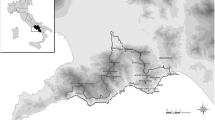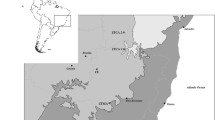Abstract
The evergreen broad-leaved forest of Rhododendron ponticum represents a special type of Mediterranean vegetation because of their relict nature (allegedly pre-glacial, Southern-Iberian and Pontic) and connection with Macaronesian-Atlantic flora. The findings of ecomorphological (growth forms) and phenological (phenology) studies point to characteristics typical of its relict character and its relationship with subtropical lauroid vegetation (greater forest stratification, larger leaves, high percentage of photosynthetic stems, scarce tomentosity, pre-flowering in a season different to Mediterranean species and closeness of autumn–winter flowering species). There are, however, links with typical Mediterranean vegetation (Quercus L. forests) that surrounds the Rhododendron stands, due to its adaptation to Mediterranean climate (sclerophyll leaves, plant and leaf duration, post-fire regeneration, fleshy fruit and fruit setting-seed dispersal seasonality). Within the community, different groups of plants show different adaptations to the same biotope, suggesting their distinct paleo-phytogeographical origins. The results confirm the singularity of this vegetation within the typically Mediterranean environment where it grows and its connections with other extra-Mediterranean types.
Similar content being viewed by others
References
Axelrod D.L. (1975). Evolution and biogeography of the Madrean-Tethyan sclerophyll vegetation. Ann. Mo. Bot. Gard. 62: 284–334
Box E.O. (1987). Plant life forms and Mediterranean environments. Ann. Bot. 45(2): 7–42
Box E.O. (1996). Plant functional types and climate at the global scale. J. Veg. Sci. 7: 309–320
Braun-Blanquet J. 1979. Fitosociología. Bases para el estudio de las comunidades vegetales. Ed. Blume. Madrid.
Cabezudo B., Navarro T., Pérez Latorre A.V., Nieto Caldera J.M. and Orshan G. (1992). Acta Bot. Malacitana 17: 229–237
Cabezudo B., Pérez Latorre A.V., Navarro T. and Nieto Caldera J.M. (1993). Estudios fenomorfológicos en la vegetación del sur de España. II. Alcornocales mesomediterráneos (Montes de MálagaMálaga). Acta Bot. Malacitana 18: 179–188
Cabezudo B., Pérez Latorre A.V. and Nieto Caldera J.M. (1995). Regeneración de un alcornocal incendiado en el sur de España (Istán, Málaga). Acta Bot. Malacitana 20: 143–151
Cabezudo B. and Pérez Latorre A.V. (2001). Notas sobre la vegetación de Andalucía. III. Acta Botanica Malacitana 26: 225–228
Campbell B.M. and Cowling R.M. (1985). Relationships between vegetation structure and the environment in the CapeSouthern Africa: a review. Ann. Bot. 43: 245–255
Caritat A., Pérez Latorre A.V. and Romo A. (1997). The distribution of ecomorphological types as related to altitude in the Montseny mountain range (NE Spain). A preliminary study. Sci. Gerunden. 23: 63–71
Castro Díez P. and Montserrat Martí G. (1998). Phenological pattern of fifteen Mediterranean phanaerophytes from Quercus ilex communities of NE Spain. Plant Ecol. 139: 103–112
Castro Díez P., Monserrat Martí G. and Cornelissen J.H.C. (2003). Trade-offs between phenology, relative growth ratelife form and seed mass among 22 Mediterranean woody species. Plant Ecol. 166: 117–129
(1986). Flora Iberica: Plantas Vasculares de la Península Ibérica e Islas Baleares. CSIC, Madrid
Chapin F.S., Autumn K. and Pugnaire F. (1993). Evolution of suites of traits in response to environmental stress. Am. Nat. 142: S78–S92
Chapin F.S., Bret-Harte M.S., Hobbie S.E. and Zong H. (1996). Plant functional types as predictors of transient responses of arctic vegetation to global change. J. Veg. Sci. 7: 347–358
Corley M.F.V. and Crundwell A.C. (1991). Additions and amendments to the mosses of Europe and the Azores. J. Bryol. 16: 337–356
Danin A. and Orshan G. (1990). The distribution of Raunkiaer life forms in Israel in relation to the environment. J. Veg. Sci. 1: 41–48
Evenari M.E., Schulze D., Kappen L., Buschbom U. and Lange O.L. (1975). Adaptive mechanisms in desert plants. In: Vernberg, E.J. (eds) Physiological Adaptation to the Environment, pp 111–129. American Institute of Biological Sciences, New York
Filibeck G., Arrigoni P.V. and Blasi C. (2004). Some phytogeographical remarks on the forest vegetation of Colchis (Western Georggia). Webbia 59(1): 189–214
Floret C., Galan M.J., Le Floc’h E., Orshan G. and Romane F. (1987). Growth form as a tool in characterising vegetation of small areas. A trial in a Mediterranean environment. Vegetatio 71: 3–11
Floret C., Galan M.J., Le Floc’h E., Orshan G. and Romane F. (1990). Growth forms and phenomorphology traits along an environmental gradient: tools for studying vegetation?. J. Veg. Sci. 1: 71–80
Givinish T.J. (1987). Comparative studies of leaf form: assessing the relative role of selective pressures and phylogenetic constraints. New Phytol. (Suppl.) 106: 131–160
Grieve B.J. (1953). The physiology of sclerophyll plants. J. Roy. Soc. West Aust. 39: 31–45
Grime J.P. (1979). Plant Strategies and Vegetation Processes. Wiley, Chichester
Guerra J., Cano M.J., Pérez Latorre A.V., Ros R.M. and Cabezudo B. (2003). Flora brio-pteridofítica de los bosques lauroides de Rhododendron ponticum L. del Parque Natural de Los Alcornocales (Cádiz-MálagaEspaña). Acta Bot. Malacitana 28: 19–36
Herrera C. 1982. Biología reproductiva de plantas leñosas mediterráneas: síndromes tropicales lejos del trópico. II Jornadas de Taxonomía Vegetal. Resúmen de conferencia, Sevilla.
Herrera C. (1984). Patrones morfológicos y funcionales en plantas del matorral mediterráneo del sur de España. Stud. Oecol. 5: 7–34
Herrera J. (1987). Flower and fruit biology in southern Spanish mediterranean shrublands. Ann. Mo. Bot. Gard. 74: 69–78
Keshet M.A., Danin A. and Orshan G. (1990). Distribution of ecomorphological types along environmental gradients in Israel: 1. Renewal bud location and leaf attributes. Ecol. Mediterranea 16: 151–161
Larcher W. (1977). Ecofisiología Vegetal. Ed. Omega, Barcelona
Le Roux A., Kyriacou X.L. and Orshan G. (1984). The phenomorphology of selected plants in Mediterranean-type ecosystems of South Africa. Bulletin de la Société Botanique de France (Actualités Botaniques) 131: 441–450
Le Roux A., Perry P. and Kyriacou X. (1989). South Africa. In: Orshan, G. (eds) Plant Phenomorphological Studies in Mediterranean Type Ecosystems, pp 159–346. Kluwer Academic Publishers, Dodrecht
Mai H.D. (1989). Development and regional differentiation of the European vegetation during the Tertiary. Plant Syst. Evol. 162: 79–91
Malato Beliz J. (1982). A Serra de Monchique. Flora e Vegetaçao. Serviço Nacional de Parques, Reservas e Patrimonio Paisagístico, Lisboa
Montenegro G., Avila G., Aljaro M.E., Osorio R. and Gómez M. (1989). Chile. In: Orshan, G. (eds) Plant Phenomorphological Studies in Mediterranean Type Ecosystems, pp 347–387. Kluwer Academic Publishers, Dodrecht
Mooney H.A. 1974. Plant form as related to environment. In: Tüx en R.(eds) Handbook of Vegetation Science IV. W. Junk Den Haag.
Mooney H.A. 1983. Plant form and function in relation to nutrient gradients. In: Day J.A.(eds) Mineral Nutrients in Mediterranean Ecosystems. South African Nature Scientist Programmes Report 71: 55–76.
Navarro T., Nieto Caldera J.M., Pérez Latorre A.V. and Cabezudo B. (1994). Estudios fenomorfológicos en la vegetación del sur de España. III. Comportamiento estacional de una comunidad de badlands. Acta Bot. Malacitana 18: 189–198
Navarro T. and Cabezudo B. (1998). Estrategias fenomorfológicas de especies de un matorral mediterráneo (AndalucíaEspaña). Acta Bot. Malacitana 23: 133–148
Nemani R. and Running S.W. (1996). Implementation of hierarchical global vegetation classification in ecosystem function models. J. Veg. Sci. 7: 337–346
Nieto Caldera J.M., Pérez Latorre A.V. and Cabezudo B. (1991). Biogeografía y series de vegetación de la provincia de Málaga (España). Acta Bot. Malacitana 16(2): 417–436
Noble I.R. and Gitay H. (1996). A functional classification for predicting the dynamics of landscapes. J. Veg. Sci. 7: 329–336
Oberdorfer E. 1960. Pflanzensoziologische Studien in Chile. Ein Vergleich mit Europa. Flora et Vegetatio Mundi 2. Weinheim.
Oppenheimer H.R. (1960). Adaptation to drought: xerophytism. UNESCO Arid Zone Research Service 15: 105–138
Orshan G. (1982). Monocharacter growth-form types as a tool in an analytic-synthetic study of growth forms in Mediterranean type ecosystems. A proposal for an inter-regional program. Ecol. Mediterranea 8: 159–171
Orshan G. (1983). Approaches to the definition of Mediterranean growth forms. In: Kruger, F.J. (eds) Mediterranean Type Ecosystems: The Role of Nutrients, pp 86–100. Ed. Springer-Verlag, Berlín / New York
Orshan G., Leroux A. and Montenegro G. (1984). Distribution of monocharacter growth form types in mediterranean plant communities of ChileSouth Africa and Israel. Bulletin de la Société Botanique de France (Actualités Botaniques) 131: 427–439
Orshan G. (1986). Plant form as describing vegetation and expressing adaptation to environment. Ann. Bot. 54: 7–37
(1989). Plant Phenomorphological Studies in Mediterranean-type Ecosystems. Kluwer Academic Publishers, Dodrecht
Parsons D.J. (1976). Vegetation structure in the mediterranean shrub communities of California and Chile. J. Ecol. 64: 435–447
Pate J.S., Dixon K.W. and Orshan G. 1984. Growth and life form characteristics of Kwongan species. In: Pate J.S. and Buurds J.S.(eds) Kwongan-Plant Life in the Sand Plain, University of Western Australia, pp. 84–100.
Pereira Días M.H. and Barros de Sa Nogueira G. (1973). Notas sobre Rhododendron ponticum L. subsp. baeticum (Boiss. and Reut.) Handel-Mazzetti do Concelho de Vouzela. Bol. Soc. Broter. 47: 125–132
Pérez Latorre A.V., Cabezudo B., Navarro T. and Nieto J.M. (1995). Caracterización fenológica y eco-morfológica de alcornocales andaluces (MálagaEspaña). Anales del Jardín Botánico de Madrid 54: 554–560
Pérez Latorre A.V., Galán de Mera A., Deil U. and Cabezudo B. (1996). Fitogeografía y vegetación del sector Aljíbico (Cádiz-MálagaEspaña). Acta Bot. Malacitana 21: 241–267
Pérez Latorre A.V., Galán de Mera A., Navas P., Navas D., Gil Y. and Cabezudo B. (1999). Datos sobre la flora y vegetación del Parque Natural de los Alcornocales (Cádiz-MálagaEspaña). Acta Bot. Malacitana 24: 133–184
Pérez Latorre A.V., Galán de Mera A. and Cabezudo B. (2000). La vegetación caracterizada por Rhododendron ponticum L. en Andalucía (España). Una complicada historia nomenclatural para una realidad fitocenológica. Acta Bot. Malacitana 25: 198–205
Pérez Latorre A.V., Caritat A. and Vilar L. (2001). Use of growth form for describing and comparing Quercus suber forest in the Iberian Peninsula. Phytocoenologia 31(1): 109–121
Pérez Latorre A.V. and Cabezudo B. (2002). Use of monocharacteristic growth forms and phenological phases to describe and differentiate plant communities in Mediterranean-type ecosystems. Plant Ecol. 161: 231–249
Pierce S.M. 1984. A synthesis of plant phenology in the fynbos biome. South African National Scientific Programmes report.
Quézel P. (1985). Definition of the Mediterranean region and the origin of its flora. In: Gómez Campo, C. (eds) Plant Conservation in the Mediterranean Area, pp 9–24. Dordrecht, The Netherlands
Ratcliffe D.A., Birks H.J.B. and Birks H.H. (1993). The ecology and conservation of the Killarney fern Trichomanes speciosum Willd. in Britain and Ireland. Biol. Conserv. 66: 231–247
Rivas Martínez S. (1987). Memoria y Mapas de las Series de Vegetación de España. MAPA-ICONA, Madrid
Romane F. (1987). Efficacié de la distribution des formes de croissance pour l’analyse de la végétation á l’échelle régionale. Thése Docteur és science, Marseille
Ruiz de la Torre J. (1971). Árboles y arbustos. Inst. Forestal de Investigaciones y Experiencias, Madrid
Sack L., Grubb P.J. and Marañón T. (2003). The functional morphology of juvenile plants tolerant of strong summer drought in shaded forest understories in southern Spain. Plant Ecol. 168: 139–163
Salvo A.E. (1990). Guía de helechos de la Península Ibérica y Baleares. Ed. Pirámide, Madrid
Smith T. and Huston M. (1989). A theory of the spatial and temporal dynamics of plant communities. Vegetatio 83: 49–69
Valcárcel V. (2002). Hacia un tratamiento taxonómico de las hiedras (Hedera L., Araliaceae) ibéricas: de caracteres morfológicos a moleculares. Anales del Jardín Botánico de Madrid 59(2): 363–368
(1987). Flora vascular de Andalucía Occidental. Ed. Ketres, Barcelona
Went F.N. (1971). Parallel evolution. Taxon 20: 197–226
Werger M.J. and Ellenbroek G.A. (1978). Leaf size and leaf consistence of a riverine forest formation along a climatic gradient. Oecologia 34: 297–308
Author information
Authors and Affiliations
Corresponding author
Rights and permissions
About this article
Cite this article
Latorre, A.V.P., Cabezudo, B. Phenomorphology and Eco-morphological Characters of Rhododendron Lauroid Forests in the Western Mediterranean (Iberian Peninsula, Spain). Plant Ecol 187, 227–247 (2006). https://doi.org/10.1007/s11258-005-6574-0
Received:
Accepted:
Published:
Issue Date:
DOI: https://doi.org/10.1007/s11258-005-6574-0




